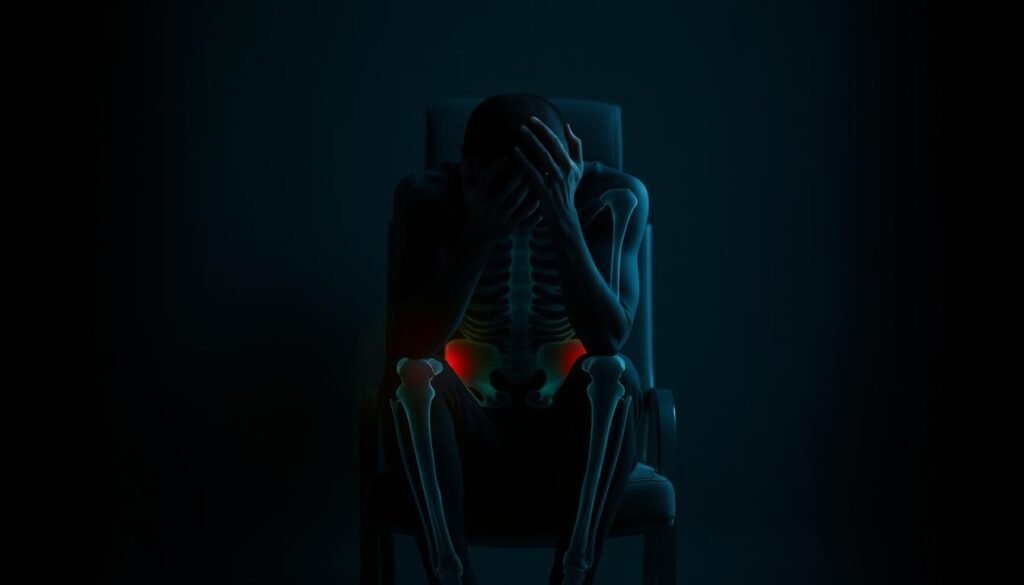Did you know around 40% of people with osteoarthritis suffer from significant fatigue? Osteoarthritis (OA) affects nearly 75% of arthritis patients globally. It is a leading cause of disability. This chronic condition isn’t just about discomfort. It’s also linked to various tough symptoms including fatigue. The connection between osteoarthritis and feeling constantly tired is complex. To understand the link, it’s important to look at factors such as joint pain and inflammation. Mood disorders may also make life harder for those affected.
This article explores the relationship between arthritis and fatigue. We’ll look into how different factors affect energy levels in people with osteoarthritis. By diving into research and real-life experiences, we aim to uncover ways to manage osteoarthritis fatigue. Our goal is to improve the quality of life for those suffering.
Key Takeaways
- Approximately 40% of people with osteoarthritis report substantial fatigue.
- A significant percentage of individuals with osteoarthritis also face depression, impacting their fatigue levels.
- Fatigue can severely limit daily activities and overall quality of life in affected individuals.
- Nonsteroidal anti-inflammatory drugs (NSAIDs) and corticosteroids may contribute to increased fatigue.
- Reduced physical activity due to osteoarthritis can lead to further muscle weakening and increased tiredness.
Understanding Osteoarthritis
Osteoarthritis (OA) is the top type of arthritis, hitting older folks hard. About 27 million adults in the U.S. are dealing with it, showing just how widespread it is. Women over 50 especially face a higher risk, with twice as many affected as men.
Symptoms of osteoarthritis don’t show up all at once. They start slow in one or a few joints. Pain in the joints can get worse at night. Osteoarthritis symptoms fatigue is also a big issue. Between 40% to 80% of people with OA talk about feeling really tired because of it. Morning stiffness is another symptom, usually lasting less than 30 minutes after waking up or sitting still for a while.
OA mainly hits the hands, knees, hips, neck, and lower back. Specifically, over 20% of people over 50 suffer from knee osteoarthritis. This can make everyday tasks, like climbing stairs or holding things, tougher.
There’s a big question about OA and fatigue. It’s clear many with OA feel very tired, but the reasons are still being studied. The link between chronic fatigue and arthritis is complex. It involves pain, swelling, and even mental health.
As OA gets worse, not being active enough can lead to weaker muscles. This makes the symptoms and daily life more difficult. Beating this fatigue and keeping joints healthy might be easier with the right strategies. Check out some tips for joint health and fatigue to help manage these issues.
What is Fatigue?
Fatigue is more than feeling extreme tiredness. It hits you physically, mentally, and emotionally. It’s not just about wanting to sleep. The fatigue definition shows it’s complex, especially with chronic illnesses like arthritis. People with osteoarthritis often feel so tired that it’s hard to do daily things. This makes them feel unfulfilled.
Arthritis-related tiredness connects to physical and mental factors. Active inflammation, trouble sleeping, and ongoing pain can make this worse. This mix causes chronic fatigue. Understanding how fatigue affects life is important, especially with ongoing health issues.
Some think fatigue is just a normal response to being busy or stressed. But for many, it’s a constant struggle that affects daily life and happiness. Knowing about fatigue helps. It means people can find ways to feel better and more energetic.

Does Osteoarthritis Cause Fatigue?
Osteoarthritis and fatigue are linked in complex ways. Chronic pain from osteoarthritis makes people feel more tired. They use a lot of energy to manage this pain, which can make them even more tired.
The body’s fight against joint damage also causes inflammation. This can add to feelings of tiredness. It’s important to understand this link to help those with osteoarthritis.
Exploring the Connection
People with osteoarthritis often feel as tired as those with rheumatoid arthritis. About 40% report feeling very tired. The reasons for this tiredness include:
- Osteoarthritis-related pain
- Pain medications
- Aging
- Weather changes
- Poor sleep
- Mental health issues
These causes create a cycle of tiredness. Studies show fatigue makes it hard for people to do everyday things. Some people need to rest more or ask for help because they’re so tired.
Research Insights on Fatigue with Osteoarthritis
Research gives us clues on how osteoarthritis leads to fatigue. A study from 2012 showed that fatigue lowers physical activity in people with knee and hip osteoarthritis. They found a high level of tiredness among them. Not being active enough can make this worse. It shows the need to slowly start exercising.
To handle fatigue, it’s good to spread out activities. Using a fatigue chart helps people track energy and adjust their plans. Occupational therapists and CBT can also help manage tiredness. NHS England offers programs for this.

| Factor | Impact on Fatigue |
|---|---|
| Pain | Increases fatigue levels significantly. |
| Poor Sleep | Exacerbates feelings of tiredness. |
| Physical Activity | Can improve energy levels but requires gradual introduction. |
| Mental Health | Influences fatigue perception and physical functioning. |
New research keeps showing how osteoarthritis is related to fatigue. This helps develop better ways to improve life for those affected.
Symptoms of Osteoarthritis
Osteoarthritis affects many and makes daily life tough. Sufferers often feel joint pain, stiffness, and swelling. They also see a reduced range of motion. These osteoarthritis symptoms fatigue lower life quality, especially with the fatigue that comes along. Many report feeling tired all the time, even with enough rest.
Fatigue feels like having the flu, with heavy limbs and extreme tiredness. It’s important to know this fatigue could come from chronic inflammation or an overactive immune system. Poor sleep due to pain makes the fatigue worse. This makes even simple daily tasks hard to do.
Things like managing inflammation, eating poorly, and stress increase fatigue. Fatigue’s time varies, from an hour to several days. It’s key to talk regularly with doctors to manage this fatigue with osteoarthritis.

| Symptom | Description |
|---|---|
| Joint Pain | Discomfort felt in the joints, often worsening with movement. |
| Stiffness | A tight sensation in the joints, particularly after periods of inactivity. |
| Swelling | Inflammation around joints, contributing to discomfort and reduced mobility. |
| Fatigue | A profound sense of tiredness and lethargy, not alleviated by rest. |
It’s crucial to address these symptoms for better well-being. Knowing how osteoarthritis symptoms fatigue play together helps in finding better treatment ways.
Factors Contributing to Fatigue in Osteoarthritis
Fatigue is a big problem for those with osteoarthritis. It makes everyday tasks hard. Joint pain and constant tiredness are major issues, making it tough to handle fatigue.
The Role of Pain
Chronic pain is a big part of osteoarthritis. It drains energy, leaving people tired all the time. Scientists have found a clear link between pain and fatigue. More pain means more fatigue. To fight fatigue, it’s key to manage pain well. This improves life quality. Learn more about fighting osteoarthritis fatigue
Impact of Sleep Disturbance
Sleeping well is hard for those in pain from osteoarthritis. Pain often disrupts sleep, leading to more fatigue. About 70% of patients don’t sleep well, which makes them even more tired. Finding a good sleeping position is essential for sleeping better and feeling less tired.
Physical Inactivity and Fatigue
Not being active is another factor that causes fatigue. Pain can limit movement, leading to weakness and more fatigue. Yet, light exercise is important. It can lower fatigue by 20-30% for those with osteoarthritis. Making exercise a part of daily routine helps manage fatigue.
Managing Osteoarthritis Fatigue
Fatigue is a big problem for people with osteoarthritis. It comes from both body and mind issues. It’s important to have a plan to deal with this kind of tiredness.
Effective Strategies for Relief
To better manage fatigue from osteoarthritis, it’s key to have a good strategy. Some helpful steps include:
- Prioritizing rest: Taking breaks often during the day is a good way to keep energy.
- Energy conservation: Finding easier ways to do everyday tasks can help save energy.
- Pain management: Medicine or therapy for pain can help you feel less tired.
- Stress-reducing activities: Relaxing activities like yoga or meditation can help with fatigue.
Importance of Exercise and Rest
Staying active is key in fighting osteoarthritis fatigue. Exercises like walking or swimming, done three to four times a week, can boost energy. Exercise not only keeps you fit; it also eases pain and helps with long-term fatigue.
Rest is just as important as exercise. Sleeping well at night and taking it easy helps beat fatigue. By focusing on both being active and resting, people with osteoarthritis can manage their fatigue better.
The Link Between Depression and Fatigue
People with osteoarthritis often deal with depression and fatigue. Studies reveal that 20% of them feel depressive. The link between depression and fatigue is strong; falling mental health can lead to more fatigue. This situation creates a hard cycle to escape from.
It’s important to look after both your mind and body to manage depression. How you feel emotionally can really affect your energy and life. For example, nearly 90% of those with chronic arthritis say they’re always tired. This shows the heavy impact these conditions have.
Fighting this cycle can be done by staying active and catching some sunlight for vitamin D. Resources like helplines and online groups are also helpful. You can learn more through this resource.
Knowing how osteoarthritis affects mental health is key. Below is a quick look at mental health issues in adults with arthritis:
| Aspect | Prevalence Among Arthritis Patients | Prevalence Among Non-Arthritis Individuals |
|---|---|---|
| Anxiety Symptoms | 22.5% | 10.7% |
| Depression Symptoms | 12.1% | 4.7% |
| Symptoms of Both | 4.1 million | N/A |
Medication Effects on Fatigue Levels
Fatigue is a big problem for many with osteoarthritis. Various osteoarthritis medications can make you feel more tired. While they help with pain, they often bring medication side effects like drowsiness. Knowing how these drugs affect you is key to feeling better.
Common Medications that May Contribute
People with osteoarthritis use different meds for relief. NSAIDs and corticosteroids are two main types. They ease pain and swelling but can make you feel more tired.
Choosing the right treatment is important. Some meds might make you more tired over time, affecting your day-to-day life. Talking with doctors about osteoarthritis medications fatigue can help. They might change your meds to suit your needs better.
| Medication Type | Common Side Effects | Impact on Fatigue |
|---|---|---|
| NSAIDs | Gastrointestinal issues, dizziness | Can cause tiredness in some patients |
| Corticosteroids | Weight gain, increased appetite | Potential for mood swings and fatigue |
| DMARDs | Increased infection risk, nausea | Fatigue reported frequently |
| Pain Relievers | Drowsiness, addiction risk | May exacerbate fatigue levels |
Conclusion
Osteoarthritis and fatigue have a well-known link. Pain, sleep problems, and medication can all make fatigue worse for those suffering. Studies show osteoarthritis is a top reason for disability globally. About 75% of arthritis cases are due to it. A big number, 40% of patients in rheumatological care, say they feel a lot of fatigue.
To help people with osteoarthritis, we need to understand how it causes fatigue. Raising awareness is key. But it’s also important to tackle pain, improve sleep, and get people moving. These steps can really boost energy and make life better.
Handling fatigue from osteoarthritis can greatly help someone’s day-to-day life and happiness. With the right care and support, patients can better handle their condition. This leads to a more fulfilled life.